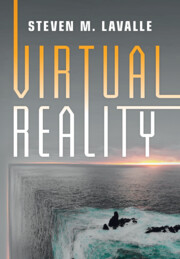Book contents
- Frontmatter
- Dedication
- Contents
- Preface
- Acknowledgments
- 1 Introduction
- 2 Bird’s–Eye View
- 3 The Geometry of Virtual Worlds
- 4 Light and Optics
- 5 The Physiology of Human Vision
- 6 Visual Perception
- 7 Visual Rendering
- 8 Motion in Real and Virtual Worlds
- 9 Tracking
- 10 Interaction
- 11 Audio
- 12 Evaluating VR Systems and Experiences
- 13 Frontiers
- References
- Image Credits
- Index
6 - Visual Perception
Published online by Cambridge University Press: 12 October 2023
- Frontmatter
- Dedication
- Contents
- Preface
- Acknowledgments
- 1 Introduction
- 2 Bird’s–Eye View
- 3 The Geometry of Virtual Worlds
- 4 Light and Optics
- 5 The Physiology of Human Vision
- 6 Visual Perception
- 7 Visual Rendering
- 8 Motion in Real and Virtual Worlds
- 9 Tracking
- 10 Interaction
- 11 Audio
- 12 Evaluating VR Systems and Experiences
- 13 Frontiers
- References
- Image Credits
- Index
Summary
This chapter transitions from the physiology of human vision to perception. How do our brains interpret the world around us so effectively in spite of our limited biological hardware? To understand how we may be fooled by visual stimuli presented by a display, you must first understand how we perceive or interpret the real world under normal circumstances. It is not always clear what we will perceive. We have already seen several optical illusions. VR itself can be considered as a grand optical illusion. Under what conditions will it succeed or fail? Section 6.1 covers perception of the distance of objects from our eyes, which is also related to the perception of object scale. Section 6.2 explains how we perceive motion. An important part of this is the illusion of motion that we perceive from videos, which are merely a sequence of pictures. Section 6.3 covers the perception of color, which may help explain why displays use only three colors (red, green, and blue) to simulate the entire spectral power distribution of light. Finally, Section 6.4 presents a statistically based model of how information is combined from multiple sources to produce a perceptual experience.
- Type
- Chapter
- Information
- Virtual Reality , pp. 129 - 154Publisher: Cambridge University PressPrint publication year: 2023



